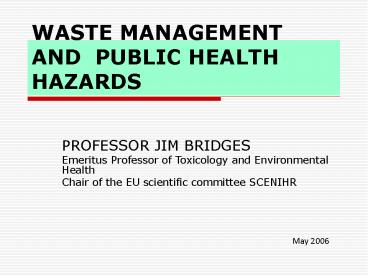WASTE MANAGEMENT AND PUBLIC HEALTH HAZARDS - PowerPoint PPT Presentation
Title:
WASTE MANAGEMENT AND PUBLIC HEALTH HAZARDS
Description:
WASTE MANAGEMENT AND PUBLIC HEALTH HAZARDS PROFESSOR JIM BRIDGES Emeritus Professor of Toxicology and Environmental Health Chair of the EU scientific committee SCENIHR – PowerPoint PPT presentation
Number of Views:243
Avg rating:3.0/5.0
Title: WASTE MANAGEMENT AND PUBLIC HEALTH HAZARDS
1
WASTE MANAGEMENT AND PUBLIC HEALTH HAZARDS
- PROFESSOR JIM BRIDGES
- Emeritus Professor of Toxicology and
Environmental Health - Chair of the EU scientific committee SCENIHR
May 2006
2
WASTE HEALTH CONSIDERATIONS
- 1.Waste contains many thousands of
chemicals and many species of micro-organisms - 2.All methods of waste treatment involve the
destruction of some substances but the creation
of others. - .
3
CONSIDERATIONS CONTINUED
- 3.The milder the treatment the less of the
original chemicals are destroyed and the less new
chemicals are created. None of these chemicals
are unique to waste management - 4.All chemicals are toxic if the exposure is
high and long enough. However for the great
majority of chemicals a threshold is found below
which adverse effects are unlikely
4
STAGES IN EVALUATION
- Hazard identification- a property of all natural
and synthetic chemicals - Assessing the risk- likelihood that adverse
effects will occur at actual exposure levels - Risk benefit analysis- Comparing risks and
benefits
5
METHODS OF WASTE TREATMENT- CONSIDERATION OF
EMISSIONS
- Microbiological/spontaneous
- Heat/combustion
- Chemical
- Physical separation
- the milder the treatment the more of the
initial contaminants are left in the waste
residue
6
CHEMICALS THAT MAY BE EMITTED FROM LANDFILLS
(microbiological/ spontaneous)
- In landfill gas- benzene, styrene and many other
volatile chemicals - From Gas Burning- dioxins, PM10, metals, nitrogen
dioxide - In the leachate, metals, ammonia
7
BIOPROSSING - SUBSTANCES EMITTED
- Volatile chemicals such as benzene, hydrogen
suphide, toluene - Microrganisms, including various pathogens
8
MATERIALS EMITTED DURING COMPOSTING
(microbiological)
- Volatile chemicals such as benzene, styrene,
methyl sulphide and toluene - Micro-organisms. Various human, animal and plant
pathogens and endotoxins - Leachate containing ammonia, metals
9
CHEMICALS EMITTED FROM AN INCINERATOR
(heat/combustion)
- Particulates eg PM10, mercury
- Less volatile organics, eg dioxins,
- chlorobenzenes
- Gases and volatile substances eg
- benzene, nitrogen dioxide
10
SUMMARY OF SUBSTANCES THAT MAY BE EMITTED BY
WASTE FACILITIES INCLUDE
- Fine particles such as PM10
- Dioxins and polycyclic aromatic hydrocarbons
- Metals
- Acid gases
- Volatile organic compounds such as benzene
- Micro-organisms
- Allergenic proteins
11
PUBLIC CONCERN (1)-DIOXINS
- Always present in MSW
- A family of chemicals created by any combustion
process - Many related compounds (eg PCBs), some very
persistent - Different dioxins have very different potencies.
Some are carcinogenic, can also affect the
nervous system, skin, reproduction outcome
12
DIOXINS CONTINUED
- Total exposure over many months/years the key
consideration - Main source of human exposure is fatty foods
- Vulnerable groups children and foetuses
13
PM1O FINE PARTICULATE MATTER
- - Range of sizes the smaller the particle the
higher the potential risk - - Many sources, eg cooking, diesel engines,
nanotechnology products
14
PM10 CONTINUED
- Acute health effects, such as respiratory and
heart. - Long term effects may include cancer
- - Vulnerable groups those with severe
respiratory and coronary disease
15
CHANGES IN INCINERATOR EMISSIONS
- Many incinerators in the 1950s-1960s caused
local pollution - Modern incinerators have 1/100th -1/1000th of
the emission levels of dioxins, PM10 and metals
compared to these old incinerators
16
CONCLUSIONS
- Waste contains natural and synthetic
chemicals. Treatment results in some chemicals
being formed - None of these chemicals is unique to waste
treatment - Key factors in determining possible health risks
are - composition of the waste and form of
treatment, - - levels of exposure of the local
residents - - safe use/disposal of residual
materials































